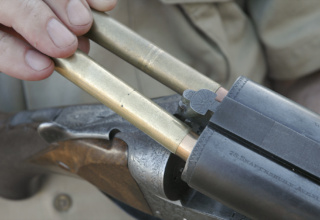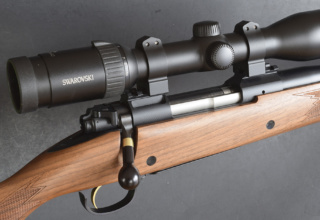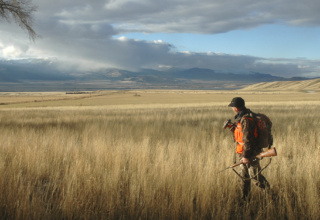Read the range, dial it up, consult your smart phone. What could go wrong?
by Wayne van Zwoll
“It dropped in its tracks at…” You fill in the yardage. A big number is thought to make the shot impressive. As if a long poke were the object of the hunt and killing from afar is harder than getting close.
First, all animals I’ve seen shot dropped in their tracks. Where else can they fall? Secondly, close approach brings the game’s senses into play, hiking the odds you’ll fail to get any shot at all.
Long shots, however, have taken on a life beyond the reach of logic.

To be fair, extending reach has been the driving force behind rifle and ammunition development since someone cut grooves in a tube five centuries ago. Balls, then bullets, won the day on battlefields and fed families on frontiers. Deadly shooting at great range remained a constant but unachievable goal as “great range” moved ever farther from the muzzle.

Francis Parkman, whose 1849 book The California and Oregon Trail chronicled travel in the pre-settlement West, wrote of using a Hawken muzzleloading rifle to fell a pronghorn at 204 paces and seeing a hunter kill a bison at nearly 300. Gracious! In a February 21, 1920 article for the Saturday Evening Post (cited by Hanson in The Plains Rifle), Horace Kephart told of finding a new Hawken that “would shoot straight with [a load of] equal weights of powder and ball. With a round ball of pure lead weighing 217 grains, patched with fine linen … and 205 grains of powder, it gave very flat trajectory….”
“Flat” is relative. Smokeless cartridges doubled the velocities achievable with a Hawkens. Within decades, sleek, jacketed, small-bore bullets were leaving the muzzle at Mach 4, their 20x scopes shrinking groups beyond the reach of the naked eye. Reports of long shots around campfires were hard to verify, but snipers with rangefinders kept records. In 1967, fabled Marine Gunnery Sergeant Carlos Hathcock killed an enemy at a reported 2,500 yards. Sniping rifles, ammunition, optics, and electronics improved, boosting effective range. Hathcock’s hit was bested in 2002. Since then, six longer shots have killed. In 2012, during Operation Slipper in Afghanistan, an Australian sniper (firing with a fellow rifleman) downed a Taliban commander at a GPS-measured 3,079 yards. The current record: 3,871 yards — over two miles!

Such eye-popping strikes hinge not only on accurate barrels and uniform ammunition, but on precise range determination. In 1926, when Henry Ford’s Model T sold for $360, Zeiss listed a Zeilvier riflescope at $45. A #1 “graticle” with post and bars spanned a center gap of 25.2 inches at 100 yards. A rangefinding reticle! Others followed. The mil dot reticle remained clean but with plenty of useful information to bring hits at extreme range. A mil, short for milliradian, is an angular measure spanning about 3.6 inches at 100 yards. On a mil dot reticle, a mil is the measure of each space between dots on a crosswire. To find range, you divide target height in mils at 100 yards by the number of spaces subtending it. If a whitetail three feet at the shoulder (10 mils at 100 yards) appears to stand two dots high, divide 2 into 10, you get 5. The deer is 500 yards away. Or, divide target size in yards by the number of mils subtended, then multiply by 1,000 to get range in yards. Here: 1/2 x 1,000 equals 500. A rear-plane reticle in variable scopes gives an accurate read at one power setting (usually the highest). Front-plane mil dot reticles correctly read range at any power.

“Trajectory-matched” dials pioneered on Leupold scopes by GreyBull Precision are a convenient alternative to rangefinding reticles. The dial is cut and inscribed so when you spin the dial to the marking that matches actual distance, sightline will meet the bullet’s arc there. Hold center. Fire. Bingo. Of course, you must first know the distance. A laser rangefinder will bring it to you fast, with precision of +/- 1 yard.
Now you can use a Bluetooth-served smart phone to put a lighted dot on your reticle for dead-on hold.
Given all this help, how can you miss?

Well, easily. To hit, you must hold the rifle still. “I can hit at …” (again, you fill in the yardage) presumes a steady rifle. Hunting, you won’t have a bench and sandbags. A bipod won’t nix pulse bounce or the rifle’s shift as the trigger moves. Add your shakes and twitches from field positions and sure-kill range is not so long after all. I’ve declined several shots at under 100 yards. Breathing hard after a climb, and limited by terrain to an offhand poke, could you promptly hit a deer’s half-screened shoulder with 90-percent certainty?

While a rest helps, it’s no panacea. Once, to shoot at an elk, I braced my rifle against a tree. As the trigger gave way, so did the bark under my hand. The .300 fired as the reticle dived beneath the bull’s brisket. Resting the rifle on something is better. But vibrations as the bullet exits can bounce a rifle away from a hard rest. On hard surfaces, pad the forend with your hand. Don’t let the barrel contact a rest.

Even when relaxed behind a supported rifle, you must consider wind. At several hundred yards, a breeze that barely tickles smoke can push a bullet inches off course. You can’t see wind, only its effect on indicators like mirage and waving grass. The greater the range, the more likely your bullet will encounter several wind conditions during its flight. Judging net effect, you’ll have to read many tea leaves.

How much to adjust your hold for wind depends on the numbers. Given a 10-mph crosswind and popular game loads, here’s a rule of thumb: Figure an inch of drift at 100 yards, twice that at 200. Triple the 200-yard drift at 300; double 300 drift-yard at 400. Here is drift for a 100-grain .243 Sierra at 2,960 fps:
- 100 yards: 0.7 in (actual drift); 1.0 in (rule of thumb drift)
- 200 yards: 2.9 in (actual drift); 2 in (rule of thumb drift)
- 300 yards : 6.7 in (actual drift); 6 in (rule of thumb drift)
- 400 yards : 12.6 in (actual drift); 12 in (rule of thumb drift)
Inside 200 yards, only wind that lifts young opossums will send your bullet outside 12-inch vitals. And hard wind at acute angles will have much less effect than a full-value crosswind.

It is exceedingly difficult to put a bullet in a deer’s chest at, say, 600 yards, even under favorable conditions. An error of just one minute of angle can cause a miss or a crippling hit. How often, from field positions, can you land nine of the first ten shots from your deer rifle inside a 12-inch circle at 600? Percentages matter. If you fire at every animal, you’ll hit a few. But you’ll likely lose some, too.
Setting Yourself Up to Miss

Visions of long-range hits have prompted long zeros — which can make you miss. You’re smart to zero so you never have to aim low. A 200-yard zero keeps bullets from most modern loads within three inches of point of aim to 260 or so. Most game is killed much closer. Zeroed for the long poke, you can easily over-shoot at more common yardage. Outfitters who’ve witnessed many shots agree: most misses are high. One fellow boasted to me that, with his magnum, he’d dropped a deer at 700 steps by holding just over its withers. Verily, to keep his bullet from sagging a foot at 700 yards, he’d have had to zero at over 600! Bullets would then strike two feet high at 300.
















